Human tryptophanyl-tRNA synthetase is switched to a tRNA-dependent mode for tryptophan activation by mutations at V85 and I311
- PMID: 17726052
- PMCID: PMC2034488
- DOI: 10.1093/nar/gkm633
Human tryptophanyl-tRNA synthetase is switched to a tRNA-dependent mode for tryptophan activation by mutations at V85 and I311
Abstract
For most aminoacyl-tRNA synthetases (aaRS), their cognate tRNA is not obligatory to catalyze amino acid activation, with the exception of four class I (aaRS): arginyl-tRNA synthetase, glutamyl-tRNA synthetase, glutaminyl-tRNA synthetase and class I lysyl-tRNA synthetase. Furthermore, for arginyl-, glutamyl- and glutaminyl-tRNA synthetase, the integrated 3' end of the tRNA is necessary to activate the ATP-PPi exchange reaction. Tryptophanyl-tRNA synthetase is a class I aaRS that catalyzes tryptophan activation in the absence of its cognate tRNA. Here we describe mutations located at the appended beta1-beta2 hairpin and the AIDQ sequence of human tryptophanyl-tRNA synthetase that switch this enzyme to a tRNA-dependent mode in the tryptophan activation step. For some mutant enzymes, ATP-PPi exchange activity was completely lacking in the absence of tRNA(Trp), which could be partially rescued by adding tRNA(Trp), even if it had been oxidized by sodium periodate. Therefore, these mutant enzymes have strong similarity to arginyl-tRNA synthetase, glutaminyl-tRNA synthetase and glutamyl-tRNA synthetase in their mode of amino acid activation. The results suggest that an aaRS that does not normally require tRNA for amino acid activation can be switched to a tRNA-dependent mode.
Figures

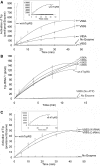
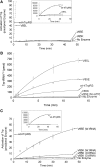
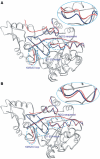
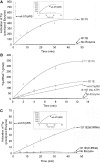
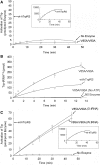
Similar articles
-
Escherichia coli tryptophanyl-tRNA synthetase mutants selected for tryptophan auxotrophy implicate the dimer interface in optimizing amino acid binding.Biochemistry. 1996 Jan 9;35(1):32-40. doi: 10.1021/bi952103d. Biochemistry. 1996. PMID: 8555191
-
Structure and activity of an aminoacyl-tRNA synthetase that charges tRNA with nitro-tryptophan.Nat Struct Mol Biol. 2005 Mar;12(3):274-5. doi: 10.1038/nsmb907. Epub 2005 Feb 20. Nat Struct Mol Biol. 2005. PMID: 15723076
-
Tryptophanyl-tRNA synthetase from Bacillus subtilis. Characterization and role of hydrophobicity in substrate recognition.J Biol Chem. 1989 Mar 15;264(8):4304-11. J Biol Chem. 1989. PMID: 2494170
-
Substrate selection by aminoacyl-tRNA synthetases.Nucleic Acids Symp Ser. 1995;(33):40-2. Nucleic Acids Symp Ser. 1995. PMID: 8643392 Review.
-
Mammalian tryptophanyl-tRNA synthetases.Biochimie. 1993;75(12):1027-39. doi: 10.1016/0300-9084(93)90002-a. Biochimie. 1993. PMID: 7515282 Review.
Cited by
-
Catalytic mechanism of the tryptophan activation reaction revealed by crystal structures of human tryptophanyl-tRNA synthetase in different enzymatic states.Nucleic Acids Res. 2008 Mar;36(4):1288-99. doi: 10.1093/nar/gkm1153. Epub 2008 Jan 7. Nucleic Acids Res. 2008. PMID: 18180246 Free PMC article.
-
Rational design and directed evolution of a bacterial-type glutaminyl-tRNA synthetase precursor.Nucleic Acids Res. 2012 Sep;40(16):7967-74. doi: 10.1093/nar/gks507. Epub 2012 May 31. Nucleic Acids Res. 2012. PMID: 22661575 Free PMC article.
-
Crystal structures of three protozoan homologs of tryptophanyl-tRNA synthetase.Mol Biochem Parasitol. 2011 May;177(1):20-8. doi: 10.1016/j.molbiopara.2011.01.003. Epub 2011 Jan 19. Mol Biochem Parasitol. 2011. PMID: 21255615 Free PMC article.
-
The structure of tryptophanyl-tRNA synthetase from Giardia lamblia reveals divergence from eukaryotic homologs.J Struct Biol. 2010 Aug;171(2):238-43. doi: 10.1016/j.jsb.2010.04.010. Epub 2010 May 8. J Struct Biol. 2010. PMID: 20438846 Free PMC article.
-
Backbone Brackets and Arginine Tweezers delineate Class I and Class II aminoacyl tRNA synthetases.PLoS Comput Biol. 2018 Apr 16;14(4):e1006101. doi: 10.1371/journal.pcbi.1006101. eCollection 2018 Apr. PLoS Comput Biol. 2018. PMID: 29659563 Free PMC article.
References
-
- Ibba M, Söll D. Aminoacyl-tRNA synthesis. Annu. Rev. Biochem. 2000;69:617–650. - PubMed
-
- Eriani G, Delarue M, Poch O, Gangloff J, Moras D. Partition of tRNA synthetases into two classes based on mutually exclusive sets of sequence motifs. Nature. 1990;347:203–206. - PubMed
-
- Cusack S. Eleven down and nine to go. Nat. Struct. Biol. 1995;2:824–831. - PubMed
-
- Zhang CM, Hou YM. Domain-domain communication for tRNA aminoacylation: the importance of covalent connectivity. Biochemistry. 2005;44:7240–7249. - PubMed
-
- Buechter DD, Schimmel P. Dissection of a class II tRNA synthetase: determinants for minihelix recognition are tightly associated with domain for amino acid activation. Biochemistry. 1993;32:5267–5272. - PubMed
Publication types
MeSH terms
Substances
LinkOut - more resources
Full Text Sources
Miscellaneous

